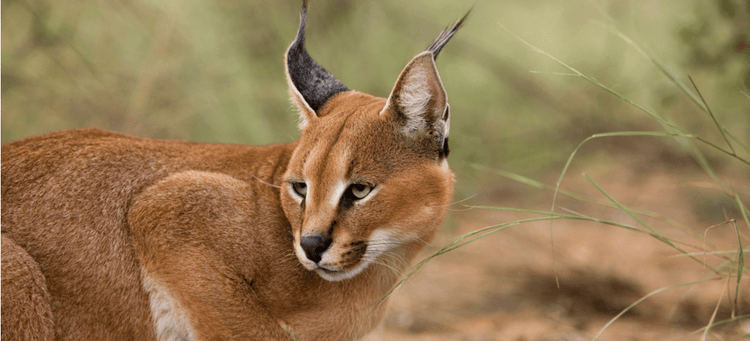
Can Caracal Cats Be Pets?
When it comes to breeds, cat lovers have their pick of the litter with common types like the Persian and Maine Coon. What about more exotic cats? While lions, tigers, and leopards are generally confined to zoos and nature preserves, residents of certain states can keep smaller wildcats as pets.
In Arizona, Arkansas, Delaware, Florida, Indiana, Maine, Mississippi, Missouri, Montana, North Dakota, Oklahoma, Pennsylvania, Texas, and South Dakota, it’s legal for licensed individuals to purchase and own caracals, a distinctive-looking wildcat.
What Is a Caracal?
A tawny-colored, mid-sized wildcat, the caracal is native to several arid expanses of the Middle East, Africa, and India. The cat is sometimes referred to as the Persian lynx and is probably most recognizable for its tufted, black ears. Those impressive ears can swivel on their axes to pick up the subtle sounds of prey. Caracals are also armed with fur-cushioned paws for silent stalking and powerful legs that can launch them as high as ten feet in the air. Combined, these features make the caracal one of the feline community’s most formidable hunters.
The caracal can grow to around 3.5 feet in length and weigh anywhere from 25 to 40 pounds. They are mostly solitary, hunting and living alone. Grown cats leave their mothers after about ten months and live to around 12 years old in the wild.
Keeping Caracals as Pets
Keeping caracals as pets isn’t like keeping just any old kitten. For one, all exotic pets tend to cost far more than traditional four-legged pals. When Justin Bieber purchased two Savannah cats (a mix of domestic cats and servals) in 2019, it wasn’t just the ethics of this decision that raised eyebrows. The pair reportedly cost the pop star $35,000 and interested buyers (famous or otherwise) can expect to pay anywhere from $1,500 to $20,000 for their own exotic cat.
Between routine costs, veterinary expenses, and unexpected mishaps, owning a domestic cat isn’t cheap. Cat lovers should expect living with a caracal or similar exotic wild breed to prove even more costly. A grown caracal can eat as much as three pounds of meat every day and they require more protein than many commercially-produced cat foods can provide. Feeding a caracal a complete and balanced diet will, as a result, usually mean working closely with a veterinarian to develop a customized nutrition plan.
Caracals don’t forget their wild origins the moment they’ve entered a home. Their independence and rambunctious spirit mean that they’ll only socialize on their own terms and the play they will engage in can be rough. Wild instincts and reserves of energy can also result in scratched-up furniture and destroyed clothing, additional expenses commonly associated with exotic cats.
Understanding Exotic Cat Ownership
There’s a reason exotic cat ownership laws vary. Individuals disagree as to whether it is advisable or ethical to keep animals like caracals confined to domestic settings. What’s more, wildcats are considered especially poor pets for households with children and other pets. Before deciding on an exotic pet, first take time to review the animal ownership laws in your area. Next, assess your lifestyle to determine whether or not such a labor-intensive pet is the right choice. If you do elect to purchase a caracal or another exotic cat, remember that the usual rules of responsible pet parenthood are even more crucial and that you’ll need to work especially closely with your veterinarian.
No need to adopt a wild animal. There are shelter cats and dogs in your area in need of a home. Browse our vast network of rescues and shelters to find the perfect pet today!